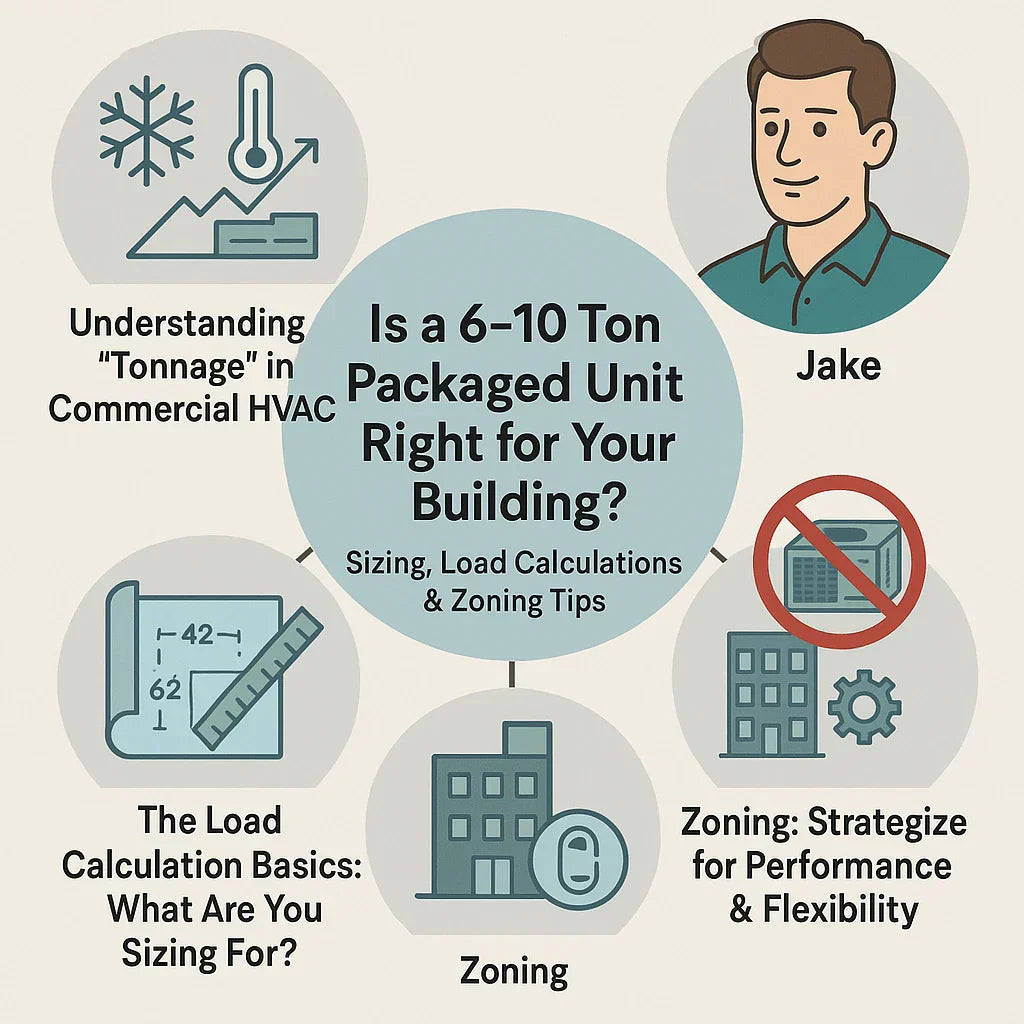Introduction
Hey there—I’m Jake, your go-to facilities guy. When I'm sizing up HVAC for a building, I’m thinking: “Is that 6–10 ton packaged unit a no‑brainer or a big mistake waiting to happen?” Let’s walk through how to figure that out—without guesswork and with real insight.
Best 6-10 Ton Commercial Packaged Air Conditioner and Gas Furnace Units
1. Understanding “Tonnage” in Commercial HVAC
What’s a ton, anyway? In HVAC, one ton = 12,000 BTU/hr of cooling. That’s the energy needed to melt one ton of ice over an hour The Furnace Outlet.
For a commercial system in the 6–10‑ton range, you're talking 72,000–120,000 BTU/hr. Residential systems top out at ~5 tons, so this is serious muscle and needs serious justification Carolina Comfort.
2. Why Proper Sizing Matters (Don't Guess!)
Oversize a unit, and you'll get short cycling, poor humidity control, mold risk—and sky‑high energy costs. Undersize it, and the system works itself to death—longer runtime, higher wear, uncomfortable interiors
Correct sizing means efficient operation, better air quality, and lower maintenance—exactly what Jake (or any facilities manager) wants
3. The Load Calculation Basics: What Are You Sizing For?
3.1 Load = Heat to Remove (Cooling Load)
A building’s cooling load is how much sensible (temperature) and latent (humidity) heat you need to remove to keep conditions stable
Factors influencing load:
-
External loads: heat gain from sun, ambient temperature, building orientation, insulation quality
-
Internal loads: people, lights, equipment, appliances, ventilation air fastechus.com
3.2 Rule-of-Thumb Sizing Methods
As a quick estimate: use 1 ton per 350–400 sq ft for commercial spaces Or:
-
Divide square footage by 500,
-
Multiply by 12,000 BTU/hr,
-
Add 380 BTU per person, 1,200 BTU for kitchens, and 1,000 BTU per window for solar gain
These give rough numbers—great for early planning, but I'd validate later.
4. Advanced Methods & Tools for Accurate Load Calculations
4.1 CLTD / CLF (Cooling Load Temp Difference) Method
ASHRAE’s CLTD/CLF approach uses lookup tables to approximate envelope heat gains within ~±20% accuracy.
4.2 ASHRAE Standards & Manual N
ASHRAE provides full frameworks for commercial load calculation—like Standard 183 or Manual N tailored to non-residential buildings Calcasieu Mechanical.
4.3 Software Tools & Professional Assessment
Apps like Wrightsoft, Carrier HAP, or manual J calculators speed and improve precision. Hiring an HVAC pro ensures real-world accuracy—ventilation loads get included and results match compliance requirements
(Understanding Load Calculations for Commercial HVAC Systems)
5. Zoning: Strategize for Performance & Flexibility
5.1 Define Zones Smartly
Divide your building into zones based on usage, orientation, occupancy, heat-generating areas, or hours of operation. Each may need different cooling loads.
5.2 Control by Zone
Use zone-specific thermostats or dampers. Don’t fight with one massive thermostat across a warehouse with offices on one side and servers on the other.
5.3 Efficiency Gains
Idle zones can be shut down to save energy. It reduces wear and balances comfort—key for cost-conscious operators.
6. Step-by-Step Sizing Guide—Jake-Style
-
Measure building area, ceiling height, window size/orientation.
-
Use a rule-of-thumb: e.g., divide sq ft by 350 → initial tonnage.
-
Collect internal load data: headcount, machinery, lighting.
-
Add solar gain allowances and adjust for insulation.
-
Run a Manual J or software tool estimate (or hire someone who does).
-
Cross-check results—commercial units in discrete steps (like 6, 8, 10 tons).
-
Factor in future growth or load additions.
-
Plan zones, adjust tonnage or install multiple units if needed.
-
Verify with contractor's printout and site data—5–7% variance is okay, 15% + needs recheck
8. Jake’s Quick Checklist (Summary Table)
| Task | Goal |
|---|---|
| Measure area & structure | Understand basic scope |
| Rule-of-thumb calculation | Early sizing baseline |
| Internal load estimation | People, equipment, heat sources |
| Use Manual J or software | High accuracy |
| Hire pros as needed | Trust but verify |
| Zone design | Tailored comfort & efficiency |
| Oversizing/undersizing check | Stay within ±10% after data |
| Future-proof load | Plan for growth or changes |
Wrap-Up
A 6–10 ton packaged unit can be spot-on—if you back it with proper load calculations, thoughtful zoning, and real-world validation. Skip the guesswork, call out the pro, and you'll avoid inefficiency headaches down the line. Jake would approve.
In the next topic we will know more about: Commercial Packaged Units vs. Split Systems: Which Is Better for Your Business?







